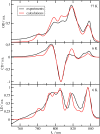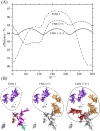Living on the edge: light-harvesting efficiency and photoprotection in the core of green sulfur bacteria
- PMID: 37404080
- PMCID: PMC10355171
- DOI: 10.1039/d3cp01321a
Living on the edge: light-harvesting efficiency and photoprotection in the core of green sulfur bacteria
Abstract
Photosynthetic green sulfur bacteria are able to survive under extreme low light conditions. Nevertheless, the light-harvesting efficiencies reported so far, in particular for Fenna-Matthews-Olson (FMO) protein-reaction center complex (RCC) supercomplexes, are much lower than for photosystems of other species. Here, we approach this problem with a structure-based theory. Compelling evidence for a light-harvesting efficiency around 95% is presented for native (anaerobic) conditions that can drop down to 47% when the FMO protein is switched into a photoprotective mode in the presence of molecular oxygen. Light-harvesting bottlenecks are found between the FMO protein and the RCC, and the antenna of the RCC and its reaction center (RC) with forward energy transfer time constants of 39 ps and 23 ps, respectively. The latter time constant removes an ambiguity in the interpretation of time-resolved spectra of RCC probing primary charge transfer and provides strong evidence for a transfer-to-the trap limited kinetics of excited states. Different factors influencing the light-harvesting efficiency are investigated. A fast primary electron transfer in the RC is found to be more important for a high efficiency than the site energy funnel in the FMO protein, quantum effects of nuclear motion, or variations in the mutual orientation between the FMO protein and the RCC.
Conflict of interest statement
There are no conflicts to declare.
Figures






Similar articles
-
Cryo-electron microscopy structure of the intact photosynthetic light-harvesting antenna-reaction center complex from a green sulfur bacterium.J Integr Plant Biol. 2023 Jan;65(1):223-234. doi: 10.1111/jipb.13367. Epub 2022 Dec 31. J Integr Plant Biol. 2023. PMID: 36125941
-
Dynamics of Energy and Electron Transfer in the FMO-Reaction Center Core Complex from the Phototrophic Green Sulfur Bacterium Chlorobaculum tepidum.J Phys Chem B. 2015 Jul 2;119(26):8321-9. doi: 10.1021/acs.jpcb.5b04170. Epub 2015 Jun 22. J Phys Chem B. 2015. PMID: 26061391
-
Native FMO-reaction center supercomplex in green sulfur bacteria: an electron microscopy study.Photosynth Res. 2016 Apr;128(1):93-102. doi: 10.1007/s11120-015-0205-y. Epub 2015 Nov 20. Photosynth Res. 2016. PMID: 26589322
-
What We Are Learning from the Diverse Structures of the Homodimeric Type I Reaction Center-Photosystems of Anoxygenic Phototropic Bacteria.Biomolecules. 2024 Mar 6;14(3):311. doi: 10.3390/biom14030311. Biomolecules. 2024. PMID: 38540731 Free PMC article. Review.
-
Light harvesting in photosystem I supercomplexes.Biochemistry. 2006 Jan 17;45(2):331-45. doi: 10.1021/bi051932o. Biochemistry. 2006. PMID: 16401064 Review.
Cited by
-
Supramolecular chirality in self-assembly of zinc protobacteriochlorophyll-d analogs possessing enantiomeric esterifying groups.Photochem Photobiol Sci. 2024 Mar;23(3):421-434. doi: 10.1007/s43630-023-00528-9. Epub 2024 Jan 24. Photochem Photobiol Sci. 2024. PMID: 38265754
-
A Simple Expression for the Screening of Excitonic Couplings between Chlorophylls as Inferred for Photosystem I Trimers.Int J Mol Sci. 2024 Aug 19;25(16):9006. doi: 10.3390/ijms25169006. Int J Mol Sci. 2024. PMID: 39201694 Free PMC article.
-
Nuclear quantum effects slow down the energy transfer in biological light-harvesting complexes.Sci Adv. 2025 Jun 6;11(23):eadw4798. doi: 10.1126/sciadv.adw4798. Epub 2025 Jun 6. Sci Adv. 2025. PMID: 40479072 Free PMC article.
References
-
- Blankenship R. E., Molecular Mechanisms of Photosynthesis, Wiley, 2021
-
- Overmann J. Cypionka H. Pfennig N. Limnol. Oceanogr. 1992;37:150–155. doi: 10.4319/lo.1992.37.1.0150. - DOI
MeSH terms
Substances
LinkOut - more resources
Full Text Sources
Medical

